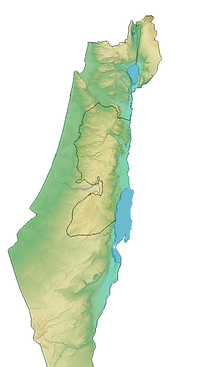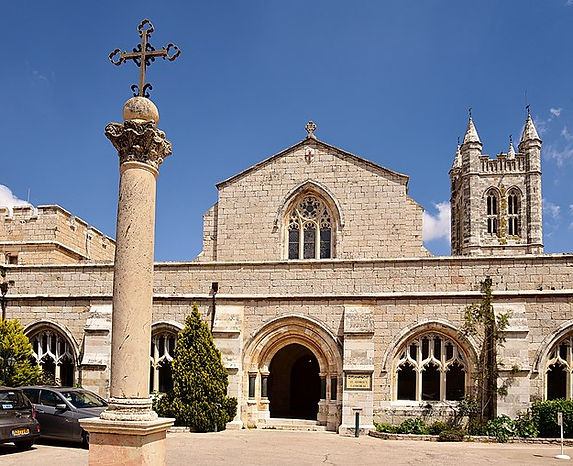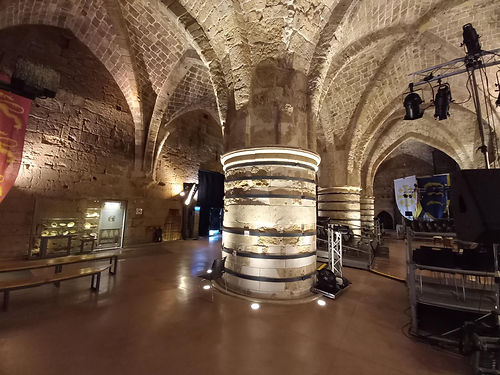
CHURCHES & MONASTERIES

CHURCH OF THE HOLY SEPULCHRE,
NATIVITY CHURCH & THE CENACLE
FAMOUS ORTHODOX CHURCHES OF JERUSALEM
CRUSADER CHURCHES
1099-1291 AD Israel


IBEAUTIFUL & OLD MONASTERIES

Armenian
Catholic
Georgian
Greek
See these Monasteries below
GREEK ORTHODOX & GREEK CATHOLIC CHURCHES
.jpg)
The Greek Orthodox Church of Jerusalem was established in the 5th century (see link). It is headquartered in the Church of the Holy Sepulchre.

See below:
FRANCISCAN CHURCHES
.jpg)
The Franciscans they first came to the Holy Land in 1217 and for 800 years they are the custodians of holy shrines, churches and they are part of daily life in Israel. St. Francis decided that the friars of his order should go out to all four corners of the world and in a short period the friars established 11 Franciscan regions, including one covering the Holy Land. Brother Elias of Cortona, one of St Francis’ earliest followers, and a small group of missionaries settled first in Israel.

See these churches below

Photo: Deror Avi
ST LOUIS THE KING CATHEDRAL OF THE MARONITE CHURCH
1889 AD - Haifa
The St. Louis the King Cathedral or the Maronite Church of St. Louis, is located in Haifa, It is the headquarter of the Maronite Catholic Patriarchate of Haifa and the Holy Land (Archieparchia Ptolemaidensis Maronitarum in Terra Sancta). It was built by Ibrahim Nasrallah and Salim Khoury and was dedicated to St. Louis IX of France (1214-1270). The construction of the church began 1883 and after interuptions it was completed in November 1889.
MARONITE CHURCH IN BARAM
Beginning of the 19th century - Baram
Baram has an beautiful ancient synagogue but also an old church that belongs to the eastern Catholic Maronite community dating from the beginning of the 19th century. Due to the sites proximity to the Lebanese border, the community was evacuated during the 1948 War of Independence. Present day members of the community today live in the nearby village of Gush Halav, Haifa and other Christian Galilean villages in the area. The church is used on Sundays and other Christian holidays as well as for special occasions such as weddings. The community has petitioned the courts for a return to the area, but their case has yet to be resolved.

Photo: Dr. Avishai Teicher
RUSSIAN ORTHODOX CHURCHES AND MONASTERIES IN ISRAEL
ANGLICAN CHURCHES
ST GEORGE CATHEDRAL
1899 AD - Jerusalem
St. George's Cathedral is an Anglican Cathedral in the Sjeik Jarrah neighbourhoud of Jerusalem. It was established in 1899 and it became the seat of the Bishop of Jerusalem. It also houses the George's College that offers theological education for clergy and laity from around the world.
Photo by Bahnfrend
.jpg)

CHRIST CHURCH
1871 - Nazareth
Christ Church in Nazareth is an Anglican church. Due to financial troubles the church couldn't be completed by 1871 and lacked its intended spire, until one was finally added 143 years later, in 2014. Nearby in Nazareth lies the famous Basilica of the Annunciation.
Photo by Rotem Hofmann
_edited.jpg)
CHRIST CHURCH JERUSALEM
1849 AD - Old City Jerusalem
Christ Church is an Anglican church. It was the original seat of the Anglican Bishop in Jerusalem until the opening of St. George's Cathedral. Consecrated 1849, it is the oldest Protestant church building in the Middle East. The church emphasises its ancient Jewish roots in its liturgy, symbols, and architecture and its congregation is mainly composed of English-speaking Jewish Christians. Both Christian and Jewish festivals are being celebrated.
Photo by Bahnfrend

'ECCE HOMO BASILICA' & 'OUR LADY OF ZION' CONVENT
1860 AD - Jerusalem
Dit is een paragraaf. Klik hier om je eigen tekst toe te voegen.
This Catholic nunnery houses a church, an hospice and an international learning center and was completed in 1862. The convent Óur lady of Zion' was founded in 1857 by Marie-Alphonse Ratisbonne, He was a French Jew and former atheist who converted and became a Catholic priest. The altar of the church of Ecce Homo was build over the left and lower part of the Roman 'Ecce Homo' Arch. The higher part of this (in the middle of this drawing) is still part of the Via Dolorosa. The Convent now houses a pilgrims guesthouse and a library.

Photo by Fallaner
Convent of the Lady of Zion originally was aimed at converting Jews to Christianity (although without using much force of pressure and with more respect for other faiths than what was common in the 19th century). During WWII some members of the Lady of Zion congregation in France and Italy helped to save many Jews (and are mentioned in the 'Rightious amongs the nations' records) and after WWII peacefull coexistence en mutual understanding of Christians and Jews became a main goal even before the 'Nostra Aetate' was declared by the Catholic Church.
1885 AD

NOTRE DAME OF JERUSALEM
This site that started as a place for pilgrims travelling to Jerusalem is an important symbol for Christians and it serves as a open interfaith meeting place. 1882 large groups of pilgrims began coming to the Holy Land under the direction of the French Assumptionists. The experience gained from there pilgrimages prompted the religious to build a center to host French pilgrims. The building would be known as Notre Dame de France. When its first cornerstone was laid on June 10, 1885 by French Catholic Assumptionist priests, it was one of the first buildings to be built outside of the Old City walls. In 1888, Notre Dame received its first pilgrims. The cornerstone of the Chapel was laid during the Eucharistic World Congress of 1893. The Chapel was consecrated the following year. In 1904, after twenty years of ongoing construction, the guest house was completed and crowned with the great statue of the Virgin Mary, a replica of Our Lady of Salvation in Paris. The Notre Dame wants to be neutral place of openness and respect of all faiths and religions within Jerusalem.

PROTESTANT CHURCHES
OTHER CATHOLIC CHURCHES
1912-1955
CHURCHES DESIGNED BY ANTONIO BARZULLI
The architect Antonio Barluzzi (1884-1960), Italian by birth, had holy architecture in his blood. His maternal grandfather was the architect responsible for the maintenance of St. Peter’s Basilica. For many years he considered entering a seminary. On the advice of his spiritual mentor and encouragement of his older brother Giulio, already an architect, he entered the engineering school to study to become an architect. Barluzzi designed an Italian hospital in Ottoman Jerusalem. In 1918 as a sergeant in the Italian army took part in the allied entry into Jerusalem. Barluzzi was asked by the Franciscans to design and build churches atop the ruins of Byzantine and Crusader churches that had been destroyed or fallen into disrepair during the Ottoman period. Thanks to the genius of the architect Barluzzi most of the Franciscan sanctuaries were rebuilt. His first designs were on Mount Tabor and in the Garden of Gethsemane. Barluzzi dedicated his life to the Holy Land, designing nine new Sanctuaries on behalf of the Franciscan Custody of the Holy Land. In total Barluzzi built or restored 24 churches, hospitals and schools between 1912 and 1955.
.jpeg)
















%20Godot13.jpg)

_heic.png)

.jpeg)







